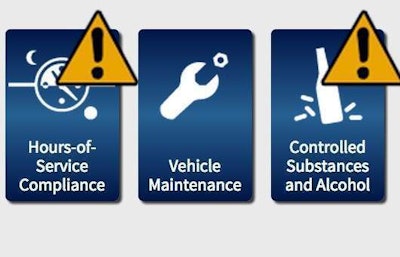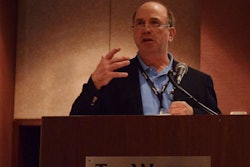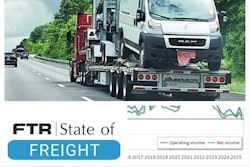
The lack of crash accountability or crash weighting in the DOT’s Compliance, Safety, Accountability program is unfair to carriers, said one of the FMCSA’s top dogs at Overdrive sister publication CCJ’s Spring Symposium this week in Birmingham, Ala.
Jack Van Steenburg, the agency’s chief safety officer, while admitting the point long-argued by the trucking industry, the Government Accountability Office and some lawmakers, did not however offer any specifics as how the agency could incorporate crash accountability into CSA scores.
 TCA’s David Heller, left, and FMCSA’s Jack Van Steenburg, right. CCJ Editor Jeff Crissey, middle, moderated the discussion on trucking regulations held this week at the CCJ Spring Symposium in Birmingham, Ala.
TCA’s David Heller, left, and FMCSA’s Jack Van Steenburg, right. CCJ Editor Jeff Crissey, middle, moderated the discussion on trucking regulations held this week at the CCJ Spring Symposium in Birmingham, Ala.And even if it could, it likely would only cover crashes that are “real obvious ones,” Van Steenburg said.
“It’s not fair to the industry. I’ll come out and say it,” Van Steenburg told the audience of trucking company managers and executives. “We recognize we have to do something for the industry.”
Currently, CSA dings carriers and their percentile rankings in the safety program for all crashes, even those that are in no way the fault of the carrier or the driver — one of the main points of contention with the industry and FMCSA’s program since its initiation in 2011.
Earlier this year, FMCSA released the results of a study in which it concluded crash accountability would not improve carrier rankings in the system and would be too cumbersome and difficult to implement.

Van Steenburg was joined in his Tuesday address by David Heller, head of policy and safety for the Truckload Carriers Association.
While CSA was a hot topic, the two also talked hours-of-service regulations, speed limiters, electronic logging devices, detention, entry-level driver training, driver drug testing and driver coercion.
Relative to CSA, aside from crash accountability concerns, Van Steenburg said he stands behind the agency’s data used to determine the rankings and BASIC scores and the program as a way to target unsafe carriers.
“Our data is accurate,” Van Steenburg said. “I challenge anybody to say the data is inaccurate. We disagree with the [2014] GAO report.”
Heller, however, pointed to the CSA rankings’ use by third parties, such as litigators and shippers, to either deny carriers business or sue. “CSA went into the board room,” Heller said, pointing to as one of the program’s successes.
“However, it’s inaccurate. The GAO said it does not produce an accurate or precise safety assessment for a carrier. We just want to be judged accurately. Give us that score,” Heller said. “Because, again, who’s viewing the scores? Shippers, plaintiff attorneys and the press — all will spew out negative reports of this industry.”
Heller also encouraged fleets and drivers to get involved in FMCSA’s hours-of-service restart study under way now. Echoing his comments earlier this month from TCA’s Safety and Security meeting held in Charlotte, Heller said more than 28,000 comments were submitted for the last hours-of-service rewrite in 2011 for the 2013-implemented rules.
The industry needs to carry that momentum into the current study on 34-hour restart provisions, Heller said, by participating in the study.
The five-month study, required by Congress in the 2015 government funding bill signed into law in December, will be “very objective,” Van Steenburg told attendees. “We have no foregone conclusions. We’ll be collecting data for the next five months, and we’ll compile that data and issue a report.”
Reimplementation of the 2013 rules suspended by the same funding bill will hinge on the report’s conclusions.
Heller said no matter the outcome of the study, the agency needs to find rules that “(a) make us safe and (b) make us profitable.”
Van Steenburg also said the agency is planning a comprehensive study on the year and a half the 2013 HOS rules were in effect in an attempt to measure crash instances per miles traveled.
The agency, he says, questions the metholodogy of a recent report from the American Transportation Research Institute that concluded that, under the 2013 rules, heavy truck crashes increased. ATRI, he said, “didn’t get into vehicle miles traveled, didn’t get into time of day and didn’t get into cause,” he said.
Other regulatory topics covered in the session included:
Safety Fitness Determination: The proposed rule, now projected to be published in September, would produce absolute scores for carriers as part of CSA in addition to the percentile rankings in CSA’s Safety Measurement System.
FMCSA has set the intervention threshold “very, very high” for the SFD scores, Van Steenburg said, somewhere around the 97th or 98th percentile, if it were measured that way, he said.
The looming Safety Fitness Determination rule also includes an adjudication process similar to CSA’s already exisiting DataQs system. The rule is currently under review by the Office of the Secretary of Transportation, he said. “Hopefully it will go on to the OMB very, very soon,” he said.
Entry-level driver training: The key question surrounding an ELDT rule, Heller said, is competency vs. hours-based training. “Would you prefer a pilot who had been in a classroom or behind the stick of a plane for a certain amount of hours or a pilot who’s competent enough to fly the plane?” Heller asked. “I’ll take competency. Well, what defines that? What defines a competent truck driver who’s going to get behind the wheel of your truck?”
And that’s currently the sticking point with the 26-member panel of industry stakeholders and regulators charged with producing the rule, he said. “What’s going to make it out of the room is the big question,” Heller said of the committee’s ongoing meetings.
Another key element of an ELDT rule, Heller said, is minimum driver age. “Can we get 18-year-olds into interstate trucks? All trucking associations support that,” he said. “We want them in trucking. We want to teach them to drive a truck and we want to teach them the right way.”
Either way, the industry needs minimum standards, he said, so that carriers know when they hire entry-level drivers what they’ve been taught and what they need to be taught.
Driver coercion, shipper accountability: The prohibition of driver coercion rule currently in the works by FMCSA would fine shippers, carriers and brokers up to $11,000 per instance of coercing or pressuring drivers to operate beyond federal regulations, such as hours-of-service rules.
Many see the rule as one that brings shippers under FMCSA’s regulatory jurisdiction, something Van Steenburg didn’t dispute when asked. “Shippers have a role in the transportation lifecycle,” he said. “They have to be held accountable. It’s very simple.”
Carriers also play a role in “managing shippers,” Van Steenburg said, and they should use any leverage they have with shippers to prevent hours-eating detention time.













